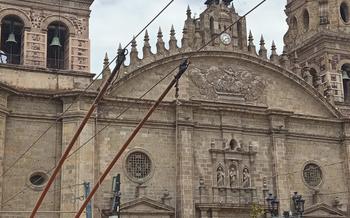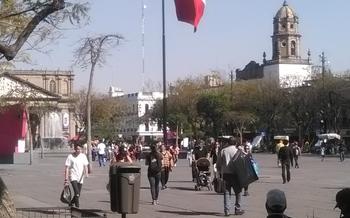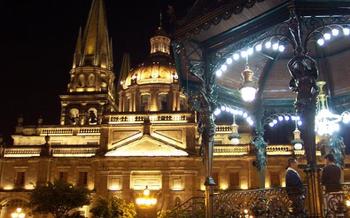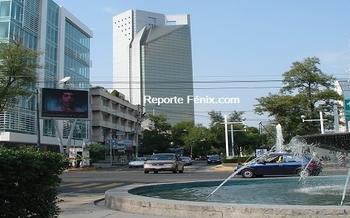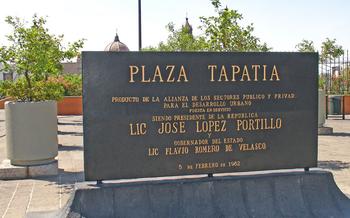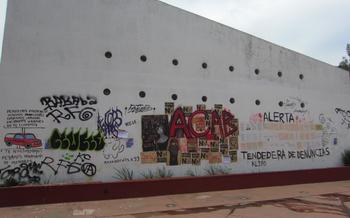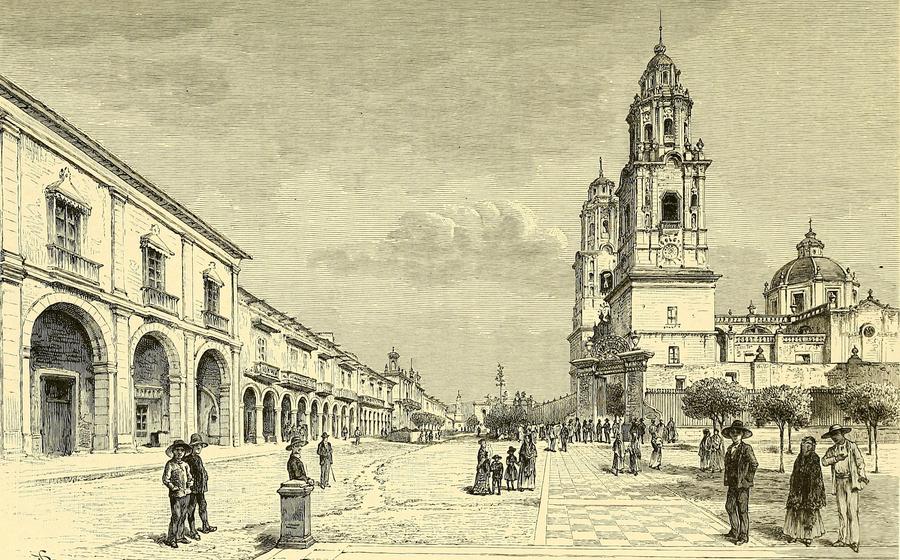
Calle Independencia
- Historical Significance
- Starting Point
- Teatro Degollado
- Plaza de la Liberación: A Historical Landmark
- Museo Regional de Guadalajara
- Rotonda de los Jaliscienses Ilustres
- Hospicio Cabañas: A Cultural Landmark
- Plaza Tapatía: A Modern Oasis in the Heart of Guadalajara
- Plaza de Armas
- Insider Tip
Historical Significance
Calle Independencia, once known as Calle San Francisco, holds a prominent place in Guadalajara's history. Established in the 16th century, it served as a vital artery connecting the city center to the San Francisco monastery. Over time, it evolved into a thriving commercial hub, attracting merchants and artisans who showcased their wares in elegant shops and galleries.
The street's architectural heritage is a testament to its rich past. Many of the buildings lining Calle Independencia date back to the 18th and 19th centuries, boasting intricate facades, wrought-iron balconies, and colorful tiles. Each building tells a story, reflecting the city's architectural evolution and the influences of various artistic movements.
Among the notable landmarks along Calle Independencia is the Teatro Degollado, an architectural gem renowned for its neoclassical grandeur. The Plaza de la Liberacion, with its iconic fountain and historical monuments, stands as a symbol of the city's struggle for independence. And the Museo Regional de Guadalajara, housed in a former convent, offers a glimpse into the region's rich cultural heritage through its extensive collection of pre-Columbian artifacts and colonial art.
Starting Point
Commence your exploration of Calle Independencia from the iconic Plaza de la Liberación, the heart of Guadalajara's historic center. This vibrant square is surrounded by remarkable landmarks, including the majestic Government Palace, the neoclassical Teatro Degollado, and the Templo Expiatorio del Santísimo Sacramento. Soak in the bustling atmosphere as you wander through the plaza, admiring the intricate architecture and vibrant energy that define this city.
As you stroll along Calle Independencia, keep an eye out for the numerous plaques and markers that provide insights into the street's rich history. These markers narrate tales of the city's past, shedding light on the events and individuals that shaped Guadalajara into the metropolis it is today.
Navigating Calle Independencia is a breeze, thanks to its pedestrian-friendly design. The wide sidewalks and cobblestone streets invite you to amble at a leisurely pace, taking in the sights and sounds of this vibrant thoroughfare. Whether you're a history buff, an architecture enthusiast, or simply someone who enjoys soaking in the local culture, Calle Independencia promises an unforgettable experience.
Teatro Degollado
Teatro Degollado, a majestic landmark on Calle. Built in the mid-19th century, this neoclassical theater has witnessed countless performances that have captivated audiences for over a century. Its elegant façade, adorned with intricate carvings and sculptures, reflects the artistic spirit of the city.
Inside, the theater's opulent interior features a horseshoe-shaped auditorium with three tiers of balconies, all adorned with lavish decorations. The ceiling, a masterpiece in itself, is adorned with stunning frescoes depicting scenes from Greek mythology, adding to the theater's grandeur.
Teatro Degollado has hosted a diverse range of performances, from opera and ballet to concerts and plays. The theater's acoustics are renowned for their clarity and resonance, making it a favorite venue for musicians and performers alike.
To fully experience the magic of Teatro Degollado, attending a show is a must. The theater offers a variety of performances throughout the year, catering to different tastes and preferences. Whether you're a classical music enthusiast or a theater buff, Teatro Degollado promises an unforgettable experience.
Insider tip: For an exclusive glimpse into the theater's history and architecture, consider taking a guided tour. These tours are offered periodically and provide fascinating insights into the stories behind the scenes.
Plaza de la Liberación: A Historical Landmark
Plaza de la Liberación is a historical square located in the heart of Guadalajara, Mexico. It is surrounded821 to commemorate the city's liberation from Spanish rule. The plaza has undergone several transformations over the years, but it has retained its historical charm and continues to be a gathering place for locals and visitors alike.
One of the most notable features of the plaza is its bandstand, which was built in 188The bandstand is a popular spot for concerts and other cultural events. The plaza is also home to a number of monuments, including a statue of Miguel Hidalgo y Costilla and a fountain dedicated to the Niños Héroes, or Child Heroes, who died defending Chapultepec Castle during the Mexican-American War.
Plaza de la Liberación is a vibrant and lively square that offers a glimpse into Guadalajara's rich history. Whether you are interested in learning about the city's past or simply want to enjoy a relaxing afternoon in a beautiful setting, Plaza de la Liberación is a must-visit destination.
Museo Regional de Guadalajara
A Treasure Trove of Guadalajara's Past
Within the walls of the Museo Regional de Guadalajara, history and culture intertwine, creating a vibrant tapestry of the city's rich heritage. Established in 1918, the museum takes visitors on a journey through time, showcasing an impressive collection of artifacts that narrate the captivating story of Guadalajara's evolution.
Unveiling the City's Roots
The museum's exhibits paint a vivid picture of Guadalajara's humble beginnings, showcasing the tools, pottery, and intricate crafts created by the region's earliest inhabitants. As you wander through the galleries, you'll discover the remnants of ancient civilizations, including the Teuchitlan and Aztatlán cultures, whose artistry and ingenuity continue to captivate modern-day admirers.
The Legacy of Colonial Guadalajara
Step into the colonial era, where Guadalajara blossomed into a vibrant cultural and economic hub. The museum houses an array of artifacts that reflect the city's transformation during this period. Admire the intricate religious artworks, marvel at the elaborate furniture, and gain insights into the daily lives of Guadalajara's colonial residents.
Modern Guadalajara: A City Transformed
The museum's collection extends into the modern era, showcasing the remarkable achievements of Guadalajara's contemporary artists, intellectuals, and visionaries. Discover the works of renowned muralists such as José Clemente Orozco and David Alfaro Siqueiros, whose vibrant creations grace the walls of the city's most iconic buildings.
Educational Programs and Guided Tours
The Museo Regional de Guadalajara is not merely a repository of artifacts; it's an active hub of learning and cultural exchange. The museum regularly hosts educational programs, workshops, and guided tours, providing visitors with an immersive and engaging experience. Learn from local experts, participate in hands-on activities, and delve deeper into the fascinating stories behind the museum's collection.
A Must-Visit for History Enthusiasts
Whether you're a history buff, an art aficionado, or simply curious about Guadalajara's captivating past, the Museo Regional de Guadalajara is a must-visit destination. Immerse yourself in the city's rich heritage, uncover its hidden stories, and leave with a newfound appreciation for the vibrant metropolis that Guadalajara has become.
Rotonda de los Jaliscienses Ilustres
The Rotunda de los Jaliscienses Ilustres is a pantheon located in the heart of Guadalajara, Mexico. It was built in 1947 to honor the memory of distinguished individuals from the state of Jalisco who have made significant contributions to various fields, including arts, sciences, politics, and social activism.
The Rotunda is a circular building with a domed roof and a colonnade of Doric columns. Inside, the walls are lined with niches that house busts and plaques commemorating the honored individuals. The Rotunda also features a central altar where wreaths and flowers are often placed in remembrance.
Some of the notable figures honored in the Rotunda include the writer Juan Rulfo, the poet Amado Nervo, the composer Jose Rolon, the scientist Ignacio L. Vallarta, and the politician Luis Michel. The Rotunda is a place of pilgrimage for many Jaliscienses who come to pay homage to their illustrious forebears.
The Rotunda is also a popular tourist destination, as it offers a glimpse into the rich history and culture of Jalisco. Visitors can learn about the lives and accomplishments of the honored individuals and gain a deeper appreciation for the state's contributions to Mexican society.
Hospicio Cabañas: A Cultural Landmark
The Hospicio Cabañas holds a significant place in Guadalajara's history and cultural landscape. Originally constructed in the 18th century as an orphanage and shelter, it now serves as a renowned cultural center, showcasing a diverse range of exhibitions and events.
One of the most captivating features of the Hospicio is its architectural grandeur. The imposing neoclassical façade, adorned with intricate carvings and sculptures, hints at the building's rich past. Inside, visitors are greeted by a series of courtyards, arcades, and vaulted ceilings that evoke a sense of awe and tranquility.
The Hospicio's transformation into a cultural center has breathed new life into this historic site. The spacious exhibition halls host a variety of art exhibitions, showcasing local and international artists. There are also regular cultural events, such as concerts, theater performances, and film screenings, that bring together the community and celebrate the city's vibrant arts scene.
Exploring the Hospicio Cabañas is a journey through time, where the echoes of the past resonate with the vibrancy of the present. It's a place where art, history, and culture converge, creating a unique and memorable experience for visitors.
Plaza Tapatía: A Modern Oasis in the Heart of Guadalajara
Plaza Tapatía, a stunning urban space in Guadalajara, is a testament to the city's commitment to blending history and modernity. This vibrant plaza, once a bustling market, underwent a remarkable transformation, emerging as a modern oasis that seamlessly integrates art, culture, and leisure.
The revitalization project, completed in 2018, aimed to create a contemporary gathering space while preserving the area's rich heritage. The plaza's design ingeniously merges modern architecture with historical elements, paying homage to Guadalajara's past while embracing its future.
Visitors to Plaza Tapatía are greeted by a captivating spectacle of interactive fountains and water features. These mesmerizing displays, synchronized with colorful lights, create a captivating ambiance, especially after sunset. The plaza's walkways, lined with lush greenery and inviting benches, offer a tranquil respite from the city's hustle and bustle.
Plaza Tapatía is not just an aesthetic marvel but also a vibrant hub for cultural events and festivals. Throughout the year, the plaza comes alive with music concerts, art exhibitions, and traditional Mexican celebrations. These events showcase the diverse cultural heritage of Guadalajara and provide a platform for local artists and performers.
Don't miss the opportunity to experience the charm of Plaza Tapatía, a space that beautifully blends the old and the new, offering a unique perspective on Guadalajara's dynamic spirit.
Plaza de Armas
A Historical Heartbeat of Guadalajara
Plaza de Armas stands as the epicenter of Guadalajara's vibrant core, a square teeming with historical significance and cultural allure. As the city's main square, it has witnessed pivotal moments in Guadalajara's evolution, serving as a gathering place for celebrations, protests, and the daily rhythm of life.
The plaza is adorned with notable landmarks that speak to Guadalajara's rich past. The Palacio de Gobierno, with its stately neoclassical facade, houses impressive murals by renowned artist Jose Clemente Orozco, depicting scenes from Mexican history. On the opposite side, the Catedral de Guadalajara, a symbol of religious devotion, captivates with its Gothic-Renaissance architecture and intricate stained glass windows.
Strolling through the Plaza de Armas, one feels immersed in the city's heartbeat. Street vendors offer local delicacies, musicians serenade passersby, and locals gather to socialize or simply bask in the warm ambiance. Cultural events and festivals frequently animate the plaza, transforming it into a vibrant stage for music, dance, and artistic expression.
Whether seeking a glimpse into Guadalajara's past or experiencing the pulse of its present, the Plaza de Armas offers an immersive journey into the heart and soul of this captivating city.
Insider Tip
To fully immerse yourself in the vibrant atmosphere of Calle Independencia, it's best to visit during the evening hours when the street comes alive with locals and tourists alike. As you stroll along the pedestrianized street, be sure to sample some of the local delicacies from the numerous food stalls and restaurants. Indulge in a refreshing tejuino, a traditional fermented corn beverage, or savor the flavors of a torta ahogada, a local sandwich drowned in a spicy tomato sauce.
For those seeking hidden gems, venture off the main street to explore the charming side streets and alleys, where you'll find quaint cafes, unique boutiques, and hidden murals. Be prepared to stumble upon unexpected treasures and experience the true essence of Guadalajara's cultural heritage.

